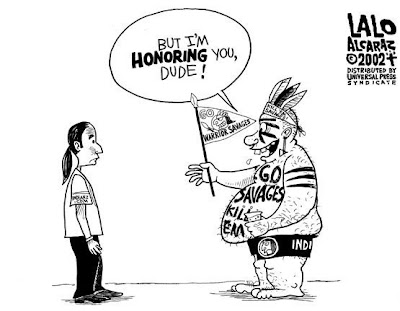Cultural appropriation is the practice through which a culture, spirituality, religion, language, or practice is co-opted, contorted, and taken by a dominant culture, oppressor, or colonizer to be assigned a new significance and used for their own purposes. Appropriation relates to cultural imperialism which is similar in that they are both forms of domination and oppression through which one culture is promoted as superior and other cultures are repressed and viewed as inferior (often indigenous cultures).
Dressing up as an "indian" is a form of cultural appropriation in which outfits and clothes regarded as sacred within Native American culture are disrespected and used to perpetuate stereotypes, discrimination, and oppression.
Why do people dress up like "indians"?
To play a character, to "go crazy," to wear a "fun costume," and to be "wild like savages." All ideas that play into negative images and ideas of Native Americans and only help to create and maintain an environment in which it is permissible to disrespect Native American culture and people.
To play a character, to "go crazy," to wear a "fun costume," and to be "wild like savages." All ideas that play into negative images and ideas of Native Americans and only help to create and maintain an environment in which it is permissible to disrespect Native American culture and people.
Whether it is wearing blackface or dressing up like an "indian," cultural appropriation is not only disrespectful and offensive, but it is inherently violent, demeaning, and oppressive.
Why is cultural appropriation so pervasive here at UC San Diego and what does that say about the environment and community here?
For more on cultural appropriation check out:
- Spiritual Appropriation As Sexual Violence by Andrea Smith
- Bitch Media: Feminist Intersection: Ke$ha and the ongoing cultural appropriation and sexualization of Native women
- Feministing: When Cultural Appropriation Goes Too Far


